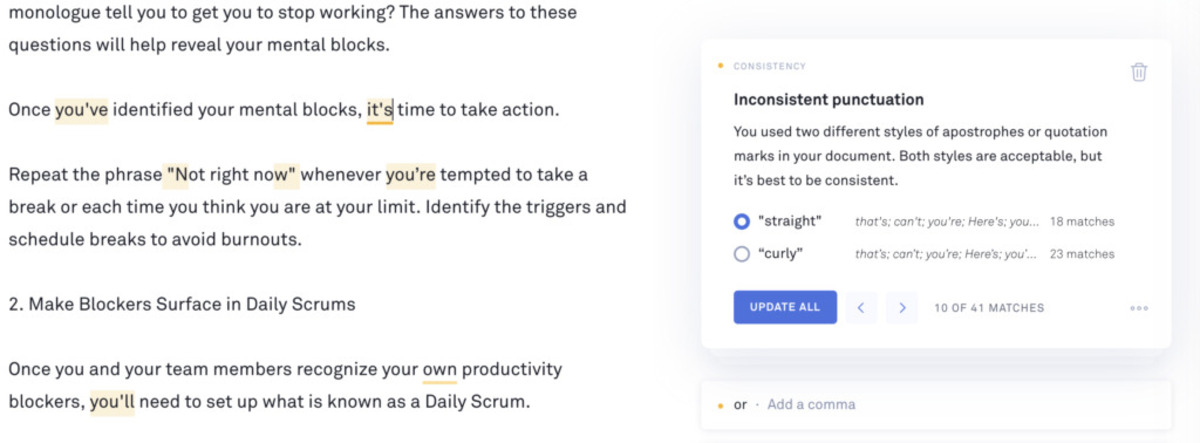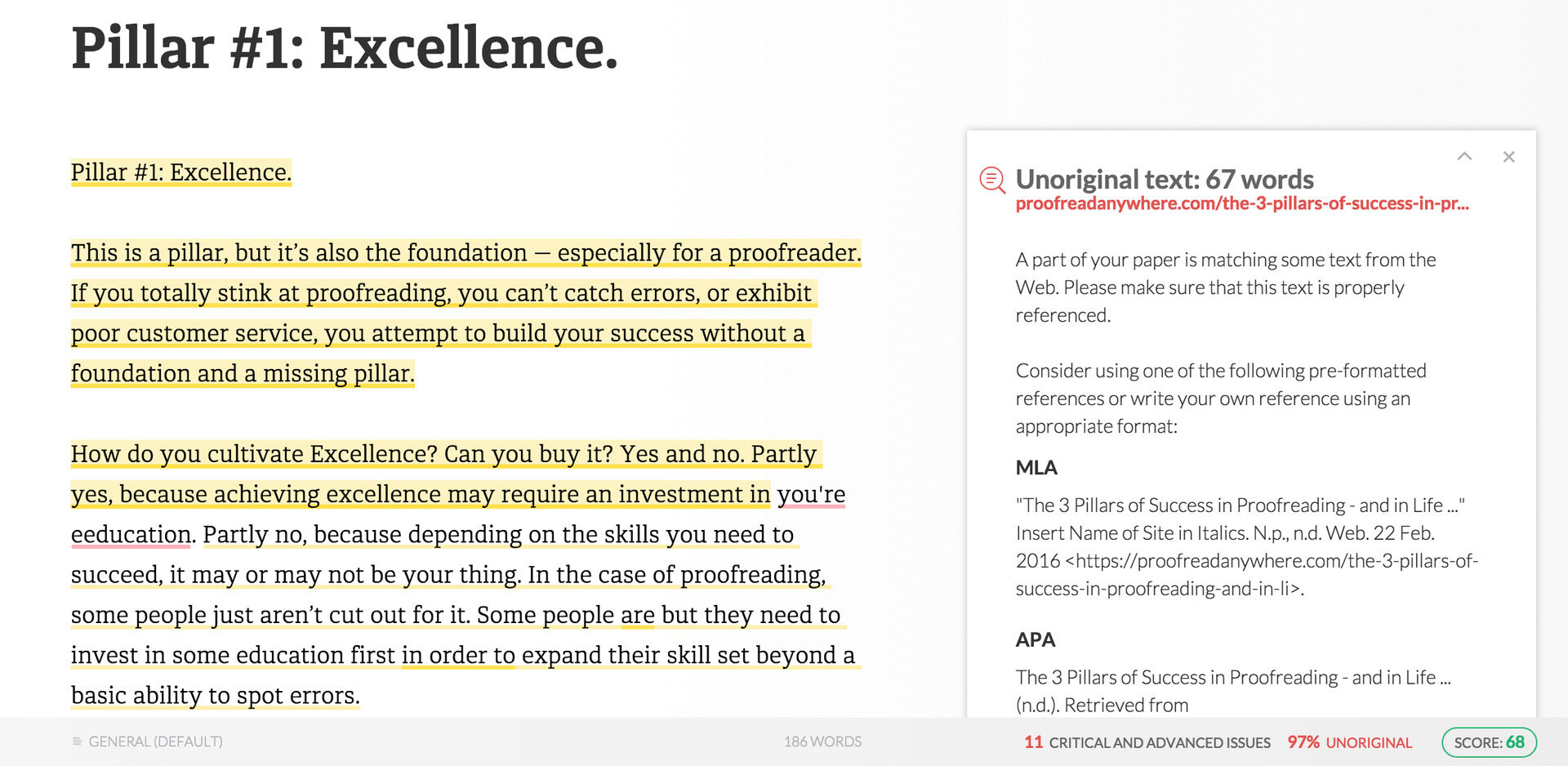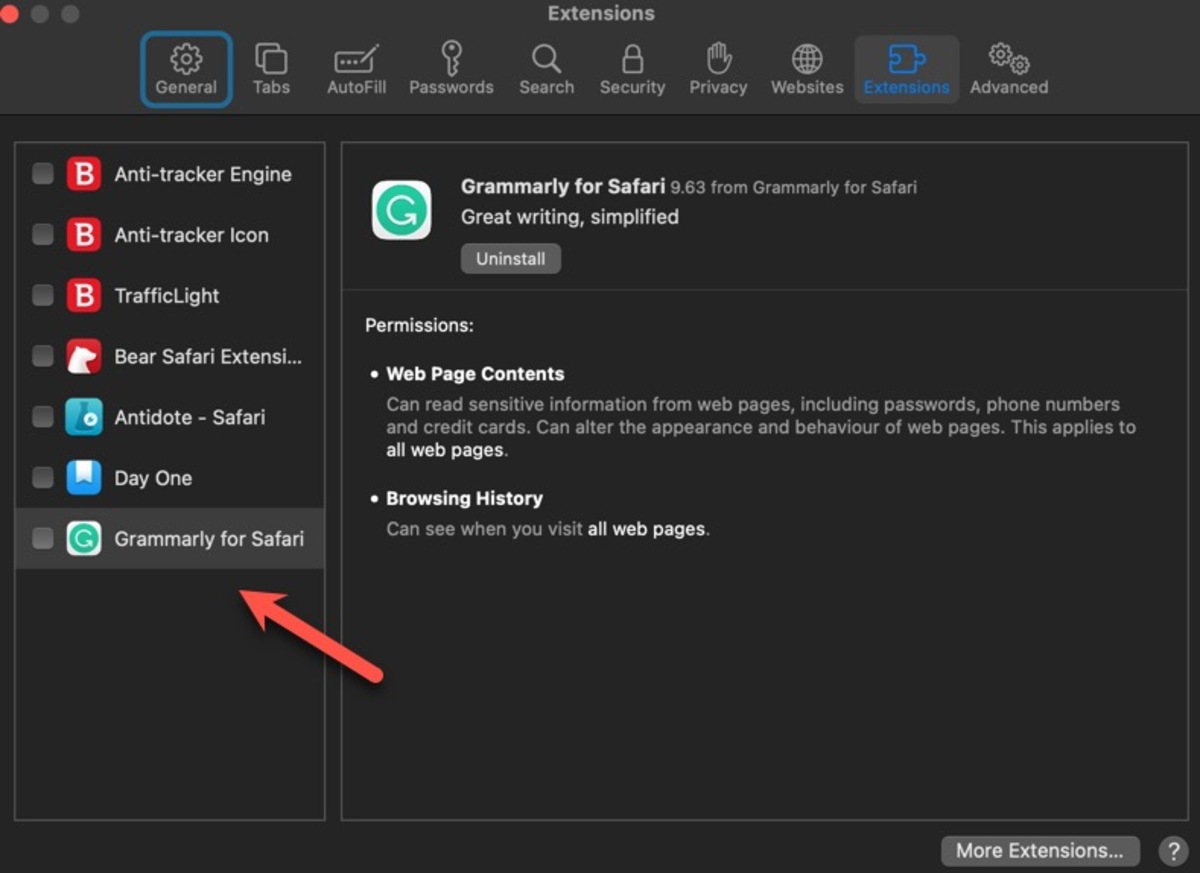Introduction
When it comes to writing, ensuring that your text is consistent and error-free is essential. Text inconsistencies can make your writing appear unprofessional and may confuse or mislead readers. Luckily, there are tools like Grammarly that can help you identify and correct these inconsistencies efficiently.
Text inconsistencies refer to errors or discrepancies in spelling, grammar, punctuation, or style within a piece of writing. These errors can occur due to various reasons, such as typing mistakes, lack of proofreading, or confusion between homophones. Recognizing and addressing these inconsistencies is crucial for maintaining the overall quality and clarity of your text.
Text inconsistencies can take different forms, including spelling errors, grammatical mistakes, or punctuation issues. Spelling errors occur when words are misspelled, either due to a typo or a lack of knowledge about the correct spelling. Grammatical errors involve improper sentence structure, verb tense confusion, or incorrect use of pronouns. Punctuation errors can include missing or incorrect punctuation marks, which can alter the intended meaning of a sentence.
Addressing text inconsistencies is essential for several reasons. Firstly, consistent and error-free writing enhances the readability and understanding of your text. It helps readers to comprehend your message without any confusion or misinterpretation. Secondly, it demonstrates your professionalism and attention to detail, which can positively impact your reputation as a writer. Lastly, consistent writing builds trust and credibility with your audience, making them more likely to engage with your content and take your message seriously.
Grammarly, a popular writing assistant tool, can help you identify and correct text inconsistencies effectively. With its advanced algorithms and language models, Grammarly can detect spelling errors, grammar mistakes, and punctuation issues automatically. It provides real-time suggestions and corrections, allowing you to make the necessary edits as you write. Grammarly also offers explanations and examples to help you understand the corrections and improve your writing skills over time.
By using Grammarly to detect and correct text inconsistencies, you can save time and effort in proofreading and editing your writing. It ensures that your text is consistent, polished, and conveys your intended message accurately. Whether you’re writing an email, an academic paper, or a blog post, Grammarly can be a valuable tool in elevating the quality of your writing and engaging your readers.
Definition of Text Inconsistencies
Text inconsistencies refer to errors or discrepancies in spelling, grammar, punctuation, or style within a piece of writing. These inconsistencies can disrupt the flow and clarity of the text, making it difficult for readers to understand the intended message.
Spelling inconsistencies occur when words are misspelled, either due to typographical errors or a lack of knowledge about the correct spelling. These errors can range from simple typos, such as accidentally swapping letters or omitting letters, to more complex errors resulting from homophones or words with similar spellings.
Grammatical inconsistencies involve improper sentence structure, verb tense confusion, or incorrect use of pronouns. These errors can include subject-verb disagreement, misplaced modifiers, dangling participles, or inconsistent use of verb tenses. When grammar inconsistencies are present, it can make the writing sound unprofessional and hinder the reader’s comprehension.
Punctuation inconsistencies can include missing or incorrect punctuation marks, which can significantly impact the meaning of a sentence. These errors can lead to misunderstandings or ambiguity in the text. Examples of punctuation inconsistencies include missing commas, misplaced apostrophes, or incorrect use of quotation marks.
Inconsistencies in writing style can also occur, particularly when multiple authors or contributors are involved in the writing process. These inconsistencies can include variations in tone, voice, word choice, or formatting. Style inconsistencies can disrupt the coherence of the text and create confusion for the reader.
Addressing text inconsistencies is crucial for ensuring the readability and professionalism of your writing. By correcting spelling errors, grammar mistakes, punctuation issues, and style inconsistencies, you can convey your message clearly and effectively to your intended audience.
Tools like Grammarly can be invaluable in identifying and correcting these text inconsistencies. With its comprehensive language database and advanced algorithms, Grammarly can analyze your writing in real-time and provide suggestions and corrections to enhance the overall quality and consistency of your text.
In summary, text inconsistencies are errors or discrepancies in spelling, grammar, punctuation, or style within a piece of writing. These inconsistencies can negatively impact the clarity and professionalism of the text. By using tools like Grammarly, you can easily identify and correct these inconsistencies, making your writing more polished and impactful.
Types of Text Inconsistencies
In writing, various types of text inconsistencies can occur, including spelling errors, grammatical mistakes, and punctuation issues. These inconsistencies can diminish the quality and clarity of your writing. Here are the three main types of text inconsistencies:
- Spelling Errors: Spelling errors refer to incorrect or misspelled words in the text. These errors can occur due to typographical mistakes, lack of knowledge about the correct spelling, or confusion between words with similar spellings. Spelling inconsistencies can range from simple typos, such as omitting or swapping letters, to more complex errors involving homophones, where words sound alike but have different meanings and spellings.
- Grammatical Errors: Grammatical inconsistencies involve errors in sentence structure, verb tense, or the proper use of pronouns. These errors can include subject-verb disagreement, incorrect use of modifiers, dangling participles, or inconsistent verb tenses. Grammatical inconsistencies make the writing sound unprofessional and can hinder the reader’s comprehension of the intended message.
- Punctuation Errors: Punctuation inconsistencies occur when there are missing or incorrect punctuation marks in the text. These errors can alter the meaning of a sentence or create confusion for the reader. Punctuation inconsistencies can include missing commas, misplaced apostrophes, incorrect use of quotation marks, or inconsistent capitalization. Proper punctuation is essential for the clarity and coherence of the text.
Identifying and addressing these text inconsistencies is vital for improving the overall quality and readability of your writing. Spelling errors can be corrected by using spell-checking tools or through manual proofreading. Grammatical errors can be fixed by reviewing grammar rules and ensuring proper sentence structure. Punctuation errors can be resolved by understanding punctuation rules and paying attention to details.
Grammarly, a popular writing assistant tool, can be incredibly helpful in detecting and correcting these types of text inconsistencies. With its advanced algorithms and extensive language database, Grammarly offers real-time suggestions and corrections for spelling errors, grammatical mistakes, and punctuation inconsistencies. It provides explanations and examples to help users improve their writing skills and avoid future inconsistencies.
By addressing spelling errors, grammatical mistakes, and punctuation issues, you can enhance the clarity, professionalism, and impact of your writing. Improving the consistency and accuracy of your text will ensure that your message is effectively communicated and understood by your audience.
Causes of Text Inconsistencies
Text inconsistencies can occur due to various reasons, including typing mistakes, lack of proofreading, auto-correct errors, and homophone confusion. Understanding these causes can help you prevent and address text inconsistencies effectively. Here are the four main causes of text inconsistencies:
- Typing Mistakes: Typing mistakes are one of the most common causes of text inconsistencies. These errors can occur due to fast typing, accidental keystrokes, or unfamiliarity with the keyboard layout. Typing mistakes can lead to misspelled words, incorrect punctuation, or even unintentional changes in sentence structure. Proofreading your writing can help you catch and correct these typing mistakes.
- Lack of Proofreading: One major cause of text inconsistencies is the lack of thorough proofreading. When writers fail to review their work meticulously, they may overlook spelling errors, grammatical mistakes, or punctuation issues. Neglecting the proofreading process can result in inconsistent text that undermines the overall quality and clarity of the writing. Taking the time to carefully proofread your work is crucial in minimizing these inconsistencies.
- Auto-Correct Errors: While auto-correct features on writing tools or devices can be useful, they are not always foolproof. Auto-correct errors can occur when the tool mistakenly corrects a word or phrase to something unintended or incorrect. These errors can lead to inconsistencies in spelling, grammar, or meaning. It is important to double-check and verify the corrections made by auto-correct to ensure the accuracy and consistency of your text.
- Homophone Confusion: Homophones are words that sound the same but have different spellings and meanings. Confusing homophones is a common cause of text inconsistencies, especially when writers rely on their auditory perception rather than visual verification. For example, mistaking “there” for “their” or “its” for “it’s” can result in incorrect use and inconsistency within the text. Being aware of homophones and paying attention to their correct usage can help prevent these inconsistencies.
Addressing these causes of text inconsistencies requires attention to detail, effective proofreading techniques, and the use of reliable writing tools such as Grammarly. By being vigilant about typing mistakes, thoroughly proofreading your work, cross-checking auto-correct suggestions, and being mindful of homophones, you can minimize text inconsistencies and ensure the accuracy and consistency of your writing.
Grammarly’s advanced algorithms and language models can help detect and correct these text inconsistencies in real-time. It provides suggestions and explanations to assist you in making necessary edits and improving your writing skills over time, reducing the occurrence of these inconsistencies.
By understanding the causes of text inconsistencies and taking proactive measures to address them, you can enhance the quality, readability, and professionalism of your writing.
Impact of Text Inconsistencies
Text inconsistencies can have a significant impact on the overall quality and effectiveness of your writing. These inconsistencies can affect how your message is perceived and understood by your audience. Here are some of the key impacts of text inconsistencies:
- Confusion and Misunderstanding: Text inconsistencies can lead to confusion and misunderstanding among readers. When there are spelling errors, grammatical mistakes, or punctuation issues, the intended meaning of the text can be misinterpreted or lost altogether. This can result in readers getting confused or having difficulty following the logic and flow of the writing.
- Loss of Credibility: Inconsistent text can diminish the credibility and professionalism of your writing. It can create the impression that you have not put in the necessary effort to ensure accuracy and consistency. Readers may view inconsistent writing as lax or haphazard, which can undermine your credibility as a writer or expert in your field.
- Distracted Readers: Text inconsistencies can be distracting for readers. When inconsistencies are present, readers may find themselves focusing on the errors rather than the content of the writing. This can disrupt the reading experience and make it more challenging for readers to engage with your message.
- Reduced Clarity and Readability: Inconsistent text can make your writing less clear and difficult to read. Spelling errors, grammatical mistakes, and punctuation issues can introduce disruptions and stumbling blocks that hinder the smooth flow of the writing. This can impede readers from understanding your ideas and key points effectively.
- Diminished Professionalism: Text inconsistencies can give the impression of unprofessionalism. In professional settings such as business communications or academic writing, consistent and error-free text is expected. When inconsistencies are present, it can create doubts about your attention to detail and level of expertise.
Recognizing the impact of text inconsistencies on your writing is crucial for ensuring that your message is conveyed accurately and effectively to your audience. By addressing these inconsistencies through proper proofreading, editing, and the use of writing tools like Grammarly, you can enhance the quality and readability of your writing. Consistent and error-free text will contribute to a more positive reader experience and improve the overall impact of your message.
Investing time and effort into identifying and correcting text inconsistencies shows your dedication to delivering high-quality content and demonstrates your professionalism as a writer. By maintaining consistency in your writing, you can foster stronger connections with your readers and ensure that your ideas are communicated accurately and persuasively.
Importance of Addressing Text Inconsistencies
Addressing text inconsistencies is crucial for several reasons. It not only improves the overall quality and professionalism of your writing but also ensures effective communication with your audience. Here are some of the key reasons why it is important to address text inconsistencies:
- Enhanced Readability: Consistent and error-free writing enhances the readability of your text. When text inconsistencies are present, it can disrupt the flow and coherence of the writing, making it more difficult for readers to understand your message. By addressing these inconsistencies, you can create a smoother reading experience and improve comprehension.
- Improved Clarity: Text inconsistencies can introduce confusion and ambiguity into your writing. By addressing spelling errors, grammatical mistakes, and punctuation issues, you provide clarity to your readers. Clear and consistent writing ensures that your ideas and information are conveyed accurately and unambiguously.
- Professionalism and Credibility: Consistent, error-free writing demonstrates professionalism and attention to detail. It shows that you value your work and take the time to ensure accuracy and consistency. By addressing text inconsistencies, you enhance your credibility as a writer or expert in your field, making readers more likely to trust and engage with your content.
- Effective Communication: The purpose of writing is to communicate ideas and convey messages to the intended audience. By addressing text inconsistencies, you ensure that your message is effectively communicated and understood by your readers. Consistent writing allows readers to focus on the content rather than being distracted by errors or inconsistencies.
- Positive Reader Experience: When your writing is consistent and error-free, readers have a positive experience engaging with your content. Inconsistent text can be distracting and hinder the reading experience. By taking the time to address text inconsistencies, you create a more enjoyable and engaging reading experience for your audience.
Addressing text inconsistencies can be achieved through thorough proofreading, editing, and the use of writing tools like Grammarly. These tools can help you identify and correct spelling errors, grammatical mistakes, and punctuation issues efficiently. Proofreading your work also allows you to catch and rectify any inconsistencies in writing style, tone, or formatting.
By maintaining consistency and accuracy in your writing, you not only improve the quality of your content but also enhance your reputation as a writer. Consistent and error-free writing showcases your professionalism, attention to detail, and commitment to delivering high-quality information to your readers.
In summary, addressing text inconsistencies is important for readability, clarity, professionalism, effective communication, and providing a positive reading experience. By ensuring consistency and addressing errors, you enhance the overall impact and effectiveness of your writing.
How Grammarly Detects Text Inconsistencies
Grammarly, a widely used writing assistant tool, employs advanced algorithms and linguistic models to detect and highlight text inconsistencies effectively. Here’s an overview of how Grammarly detects text inconsistencies:
- Contextual Analysis: Grammarly utilizes contextual analysis to understand the meaning and context of the text. It analyzes the surrounding words and phrases to determine the appropriate spelling, grammar, and punctuation usage. By considering the context, Grammarly can identify discrepancies and inconsistencies within the text.
- Machine Learning: Grammarly employs machine learning techniques to continually improve its ability to detect text inconsistencies. With millions of data points and examples, Grammarly’s algorithms learn patterns and common errors, allowing them to make accurate suggestions and corrections.
- Grammar Rules and Style Guides: Grammarly incorporates an extensive database of grammar rules and style guides. It checks your writing against these rules and guidelines to identify inconsistencies in spelling, grammar, or punctuation. These rules help ensure that your writing adheres to acceptable standards and conventions.
- Natural Language Processing: Grammarly utilizes natural language processing (NLP) techniques to understand the structure and syntax of the text. This enables it to identify grammatical errors, sentence fragments, subject-verb disagreements, and other inconsistencies that may affect the clarity and readability of the writing.
- Spell-Checking: Grammarly includes a robust spell-checking feature that can spot and correct spelling errors. It compares individual words against an extensive dictionary to identify words that are misspelled or used incorrectly. This helps eliminate spelling inconsistencies and ensures the accuracy of your writing.
- Punctuation and Sentence Structure Analysis: Grammarly’s algorithms analyze punctuation usage and sentence structure to identify errors and inconsistencies in punctuation marks. It can detect incorrect comma placement, missing or redundant punctuation, and other punctuation-related issues that affect the correctness and clarity of your text.
Using these techniques, Grammarly provides real-time suggestions and corrections as you write. It underlines potential text inconsistencies and provides explanations for the suggested changes, helping you understand why the inconsistency occurred and how to fix it.
Grammarly also offers customization options, allowing you to set specific style preferences and adjust its level of strictness in detecting certain types of errors. This ensures that you have control over the corrections made and can tailor the tool to suit your writing style and preferences.
By leveraging its advanced algorithms and language models, Grammarly helps writers address text inconsistencies efficiently and effectively. It offers a valuable tool to assist in producing high-quality and consistent writing.
Advantages of Using Grammarly to Correct Text Inconsistencies
Grammarly offers several advantages when it comes to correcting text inconsistencies. Its advanced features and user-friendly interface make it a valuable tool for writers. Here are some of the advantages of using Grammarly to address text inconsistencies:
- Real-Time Suggestions: Grammarly provides real-time suggestions and corrections as you write, highlighting text inconsistencies and offering alternatives. This allows you to immediately address errors and ensure the consistency and accuracy of your writing.
- Detailed Explanations: When making suggestions or corrections, Grammarly provides detailed explanations. It helps you understand the reasons behind the inconsistency and teaches you how to improve your writing skills. Understanding the underlying issues can prevent future inconsistencies from occurring.
- Comprehensive Error Detection: Grammarly’s algorithms are designed to detect a wide range of text inconsistencies, including spelling errors, grammatical mistakes, punctuation issues, and even inconsistencies in style or tone. It offers a comprehensive approach to identifying and resolving inconsistencies in your writing.
- Customization Options: Grammarly allows you to customize the tool based on your writing preferences and goals. You can select different writing goals, such as academic, professional, or casual, to align the corrections and suggestions with your specific writing style and audience. Customization ensures that Grammarly is an adaptable tool, catering to your unique needs.
- Easy Integration: Grammarly seamlessly integrates with various platforms and applications, including web browsers, Microsoft Office, and Google Docs. This makes it convenient to use across different devices and ensures that you can access Grammarly’s corrections and suggestions whenever and wherever you write.
- Language Diversity: Grammarly supports multiple languages, making it an excellent choice for writers who work in different languages or for non-native English speakers. It helps identify and correct inconsistencies in writing across various languages, ensuring accuracy and consistency regardless of the language being used.
- Enhances Writing Skills: Regular use of Grammarly can improve your writing skills over time. By consistently receiving suggestions and learning from the explanations, you can develop a better understanding of commonly made errors and how to avoid them. This improves your ability to identify and address text inconsistencies independently.
Using Grammarly to correct text inconsistencies saves time and effort compared to manually proofreading and editing your writing. It streamlines the process and provides you with the tools and guidance needed to produce error-free and consistent writing.
However, it is important to note that while Grammarly is a helpful tool, it should not replace critical thinking or the need for human editing. It is always recommended to review and revise your writing even after using Grammarly to ensure it meets your intended goals and matches your unique writing style.
In summary, Grammarly offers several advantages in correcting text inconsistencies. Its real-time suggestions, detailed explanations, customizable features, and easy integration make it a valuable tool that enhances your writing skills and helps you produce high-quality, error-free, and consistent writing.
Conclusion
Addressing text inconsistencies is essential for maintaining the quality, clarity, and professionalism of your writing. Spelling errors, grammatical mistakes, and punctuation issues can hinder the readability and understanding of your message. By using tools like Grammarly, you can efficiently detect and correct these inconsistencies, enhancing the overall impact and effectiveness of your writing.
Grammarly’s advanced algorithms and linguistic models are designed to detect text inconsistencies in real-time. It provides suggestions and explanations, helping you understand the errors and improve your writing skills over time. By utilizing Grammarly, you can save time and effort in proofreading and editing, ensuring consistent and error-free writing.
The advantages of using Grammarly to address text inconsistencies are numerous. Its real-time suggestions, detailed explanations, and comprehensive error detection make it a valuable tool for writers. Customization options, easy integration, and language diversity further enhance the user experience, while the tool’s ability to enhance writing skills is a significant benefit.
However, it is important to remember that Grammarly should not replace critical thinking and manual proofreading. It is a powerful tool that aids in the identification and correction of text inconsistencies, but it is still crucial for writers to review and revise their work for accuracy and adherence to their unique goals and style.
In conclusion, addressing text inconsistencies is crucial for effective communication and maintaining clarity in your writing. By utilizing tools like Grammarly and following good proofreading practices, you can ensure that your writing is consistent, error-free, and easily understood by your audience. Consistent and accurate writing enhances your professionalism, credibility, and reader engagement, making your message more impactful.

























